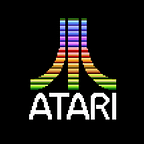An interview with game designer Nick Paladino
The Atari VCS team has been following the development of the game Rift World for a while now. Rift World is the effort of Nick Paladino, a game development graduate student. Nick publishes a steady stream of images and short videos to his Twitter feed (@Paladino954), and you can’t help but be drawn into the colorful, playful, floating world that he is building. We have even taken the demo for a spin, and found the kinetic nature of the environment and the low-gravity movement to be particularly enjoyable.
Nick was kind enough to take a moment to answer some questions for us. Give them a read.
How did you start the design process?
Before I began visual design for Rift World, I built a framework through writing. I find that short pen and paper stories are a quick way to explore world building (players fond of Dungeons and Dragons are likely to agree with this). I wrote short stories that sketched out potential universes which could nestle into a larger narrative, until I ultimately settled upon a shattered, earth-like kingdom that was located within a rift dimension filled with magical energy.
How did you settle on a visual style and the low poly aesthetic?
The visual style and low poly aesthetic are purely derived from personal taste. I have always found the look of low poly games to be quite pleasing to the eye and the nature of low poly designs rather intriguing. There can be a surprising amount of detail portrayed to the player even when the models are rather simplistic. Low poly provides just enough detail for the player’s mind and imagination to fill in the gaps. As for the visual style, I wanted to craft a world that felt both magical and whimsical, with just enough mystery to keep things interesting.
Movement, especially vertical movement, is such an important part of the gameplay in Rift World. Was that a goal you had when you first started or has it evolved as your work progressed?
The movement system within Rift World is something that was heavily iterated upon throughout the development of the game. There were a number of design challenges that ultimately pushed the movement system to become what it is today. With the nature of the game being a bullet hell, it quickly became apparent that the player’s horizontal movement needed to be very fast so they constantly dodge the onslaught of projectiles present in the game. I stumbled upon the idea of adding more vertical movement when early player testing highlighted how frequently players moved upwards, scaling the vertical levels. I decided to lean into this style of play, and ultimately created movement that almost feels as if the player is flying. At first I was worried that the new mechanics would decrease the challenge of gameplay, but testing revealed that not only was the style of play more enjoyable, it was just as difficult. So it stuck!
How important is feedback from gamers and other developers?
I believe that feedback, especially early feedback, is critical for making enjoyable games. Designers and developers can quickly find themselves inside an echo chamber, which can lead to boring gameplay, unintuitive systems, and game-ruining bugs. Feedback from other developers, and more importantly, players, allows in-development games to grow and iterate, and ultimately reach their full potential. I believe that the moment a game is able to be tested by someone other than the developer, no matter how early, that testing will lead to a better outcome.
What are some of your favorite games?
This is one of the hardest questions I am frequently asked and I guarantee my answer changes every time. In the right setting I can find myself enjoying most any game, or at the very least, studying what the game does well and what it can do better. A few of my favorite games are cooperative masterpieces, like any of the early Halo titles, Cup Head, or Castle Crashers. Strategy games such as Northgard, Age of Empires, or any Civilization game. Games that allow me to express my creativity such as Minecraft or Terraria. An honorable mention has to go to the Mount and Blade series, as I have always been part of the cult following for those titles.
When are you planning on launching Rift World?
Rift World is scheduled to launch between Q2 and Q3 of 2021. This timeframe will allow me to finish the current story mode of the game and should provide ample time for polish and testing. I already have a handful of exciting post-release updates planned, but I’ll be keeping the nature of these updates a secret for now.
How can people who are interested in your project follow your progress?
I have been sharing and documenting my entire journey developing Rift World on my personal Twitter account (@Paladino954). This would be the best way to stay up to date when following the project.
